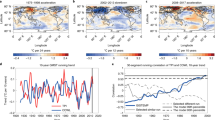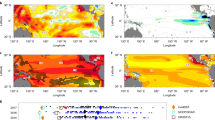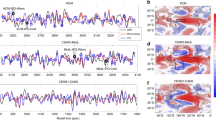Abstract
Global mean surface temperature change over the past 120 years resembles a rising staircase1,2: the overall warming trend was interrupted by the mid-twentieth-century big hiatus and the warming slowdown2,3,4,5,6,7,8 since about 1998. The Interdecadal Pacific Oscillation9,10 has been implicated in modulations of global mean surface temperatures6,11, but which part of the mode drives the variability in warming rates is unclear. Here we present a successful simulation of the global warming staircase since 1900 with a global ocean–atmosphere coupled model where tropical Pacific sea surface temperatures are forced to follow the observed evolution. Without prescribed tropical Pacific variability, the same model, on average, produces a continual warming trend that accelerates after the 1960s. We identify four events where the tropical Pacific decadal cooling markedly slowed down the warming trend. Matching the observed spatial and seasonal fingerprints we identify the tropical Pacific as a key pacemaker of the warming staircase, with radiative forcing driving the overall warming trend. Specifically, tropical Pacific variability amplifies the first warming epoch of the 1910s–1940s and determines the timing when the big hiatus starts and ends. Our method of removing internal variability from the observed record can be used for real-time monitoring of anthropogenic warming.
This is a preview of subscription content, access via your institution
Access options
Subscribe to this journal
Receive 12 print issues and online access
$259.00 per year
only $21.58 per issue
Buy this article
- Purchase on Springer Link
- Instant access to full article PDF
Prices may be subject to local taxes which are calculated during checkout




Similar content being viewed by others
References
Brönnimann, S. Pacemakers of warming. Nature Geosci. 8, 87–89 (2015).
Trenberth, K. E. Has there been a hiatus? Science 349, 691–692 (2015).
Meehl, G. A., Arblaster, J. M., Fasullo, J. T., Hu, A. X. & Trenberth, K. E. Model-based evidence of deep-ocean heat uptake during surface-temperature hiatus periods. Nature Clim. Change 1, 360–364 (2011).
Kosaka, Y. & Xie, S.-P. Recent global-warming hiatus tied to equatorial Pacific surface cooling. Nature 501, 403–407 (2013).
England, M. H. et al. Recent intensification of wind-driven circulation in the Pacific and the ongoing warming hiatus. Nature Clim. Change 4, 222–227 (2014).
Dai, A., Fyfe, J. C., Xie, S.-P. & Dai, X. Decadal modulation of global surface temperature by internal climate variability. Nature Clim. Change 5, 555–559 (2015).
Schmidt, G. A., Shindell, D. T. & Tsigaridis, K. Reconciling warming trends. Nature Geosci. 7, 158–160 (2014).
Santer, B. D. et al. Volcanic contribution to decadal changes in tropospheric temperature. Nature Geosci. 7, 185–189 (2014).
Zhang, Y., Wallace, J. M. & Battisti, D. S. ENSO-like interdecadal variability: 1900–93. J. Clim. 10, 1004–1020 (1997).
Power, S., Casey, T., Folland, C., Colman, A. V. & Mehta, V. Inter-decadal modulation of the impact of ENSO on Australia. Clim. Dynam. 15, 319–324 (1999).
Maher, N., Sen Gupta, A. & England, M. H. Drivers of decadal hiatus periods in the 20th and 21st centuries. Geophys. Res. Lett. 41, 5978–5986 (2014).
Fyfe, J. C. et al. Making sense of the early-2000s global warming slowdown. Nature Clim. Change 6, 224–228 (2016).
Meehl, G. A., Teng, H. & Arblaster, J. M. Climate model simulations of the observed early-2000s hiatus of global warming. Nature Clim. Change 4, 898–902 (2014).
Smith, T. M., Reynolds, R. W., Peterson, T .C. & Lawrimore, J. Improvements to NOAA’s historical merged land-ocean surface temperature analysis (1880–2006). J. Clim. 21, 2283–2296 (2008).
Thompson, D. W. J., Kennedy, J. J., Wallace, J. M. & Jones, P. D. A large discontinuity in the mid-twentieth century in observed global-mean surface temperature. Nature 453, 646–649 (2008).
Huang, B. et al. Extended reconstructed sea surface temperature version 4 (ERSST.v4). Part I: upgrades and intercomparisons. J. Clim. 28, 911–930 (2015).
Brönnimann, S. Early twentieth-century warming. Nature Geosci. 2, 735–736 (2009).
Bindoff, N. L. et al. in Climate Change 2013: The Physical Science Basis (eds Stocker, T. F. et al.) 867–952 (IPCC, Cambridge Univ. Press, 2013).
Wilcox, L. J., Highwood, E. J. & Dunstone, N. J. The influence of anthropogenic aerosol on multi-decadal variations of historical global climate. Environ. Res. Lett. 8, 024033 (2013).
Meehl, G. A., Hu, A. & Santer, B. D. The mid-1970s climate shift in the Pacific and the relative roles of forced versus inherent decadal variability. J. Clim. 22, 780–792 (2009).
Thompson, D. M. et al. Early twentieth-century warming linked to tropical Pacific wind strength. Nature Geosci. 8, 117–121 (2015).
Knutti, R. & Hegerl, G. C. The equilibrium sensitivity of the Earth’s temperature to radiation changes. Nature Geosci. 1, 735–743 (2008).
Otto, A. et al. Energy budget constraints on climate response. Nature Geosci. 6, 413–414 (2013).
Thompson, D. W., Wallace, J. M., Jones, P. D. & Kennedy, J. J. Identifying signatures of natural climate variability in time series of global-mean surface temperature: methodology and insights. J. Clim. 22, 6120–6141 (2009).
Fyfe, J. C., Gillett, N. P. & Thompson, D. W. J. Comparing variability and trends in observed and modelled global-mean surface temperature. Geophys. Res. Lett. 37, L16802 (2010).
Victor, D. G. & Kennel, C. F. Ditch the 2 °C warming goal. Nature 514, 30–31 (2014).
Boer, G. J. et al. The decadal climate prediction project. Geosci. Model Dev. Discuss. http://dx.doi.org/10.5194/gmd-2016-78 (2016).
Morice, C. P., Kennedy, J. J., Rayner, N. A. & Jones, P. D. Quantifying uncertainties in global and regional temperature change using an ensemble of observational estimates: the HadCRUT4 data set. J. Geophys. Res. 117, D08101 (2012).
Hansen, J., Ruedy, R., Sato, M. & Lo, K. Global surface temperature change. Rev. Geophys. 48, RG4004 (2010).
Karl, T. R. et al. Possible artifacts of data biases in the recent global surface warming hiatus. Science 348, 1469–1472 (2015).
Hersbach, H. et al. ERA-20CM: A Twentieth Century Atmospheric Model Ensemble ERA Report Series 16 (ECMWF, 2013); http://www.ecmwf.int/en/elibrary/9870-era-20cm-twentieth-century-atmospheric-model-ensemble
Delworth, T. L. et al. GFDL’s CM2 global coupled climate models. Part I: formulation and simulation characteristics. J. Clim. 19, 643–674 (2006).
Tokinaga, H., Xie, S.-P., Deser, C., Kosaka, Y. & Okumura, Y. M. Slowdown of the Walker circulation driven by tropical Indo-Pacific warming. Nature 491, 439–443 (2012).
Maher, N., McGregor, S., England, M. H. & Sen Gupta, A. Effects of volcanism on tropical variability. Geophys. Res. Lett. 42, 6024–6033 (2015).
Flato, G. et al. in Climate Change 2013: The Physical Science Basis (eds Stocker, T. F. et al.) 741–866 (IPCC, Cambridge Univ. Press, 2013).
Sen, P. K. Estimates of the regression coefficient based on Kendall’s tau. J. Am. Stat. Assoc. 63, 1379–1389 (1968).
Acknowledgements
The authors are grateful to the Geophysical Fluid Dynamics Laboratory model developers for making the coupled model version 2.1 available. Y.K. is supported by the Japanese Ministry of Education, Culture, Sports, Science and Technology through Grant-in-Aid for Young Scientists 15H05466 and the Arctic Challenge for Sustainability (ArCS) Project, and by the Japanese Ministry of Environment through the Environment Research and Technology Development Fund 2-1503. S.-P.X. is supported by the US National Science Foundation and National Oceanic and Atmospheric Administration.
Author information
Authors and Affiliations
Contributions
Y.K. and S.-P.X. designed the study and wrote the paper. Y.K. performed the model experiments and analysis in consultation with S.-P.X.
Corresponding authors
Ethics declarations
Competing interests
The authors declare no competing financial interests.
Supplementary information
Supplementary Information
Supplementary Information (PDF 10437 kb)
Rights and permissions
About this article
Cite this article
Kosaka, Y., Xie, SP. The tropical Pacific as a key pacemaker of the variable rates of global warming. Nature Geosci 9, 669–673 (2016). https://doi.org/10.1038/ngeo2770
Received:
Accepted:
Published:
Issue Date:
DOI: https://doi.org/10.1038/ngeo2770
This article is cited by
-
El Niño and the AMO Sparked the Astonishingly Large Margin of Warming in the Global Mean Surface Temperature in 2023
Advances in Atmospheric Sciences (2024)
-
Strengthening atmospheric circulation and trade winds slowed tropical Pacific surface warming
Communications Earth & Environment (2023)
-
Robustness of the long-term nonlinear evolution of global sea surface temperature trend
Geoscience Letters (2022)
-
Emergence of climate change in the tropical Pacific
Nature Climate Change (2022)
-
The role of sea surface temperature variability in changes to global surface air temperature related to two periods of warming slowdown since 1940
Climate Dynamics (2022)



